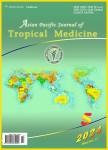Is glucose-6-phosphate dehydrogenase deficiency more prevalent in Carrion's disease endemic areas in Latin America?
Is glucose-6-phosphate dehydrogenase deficiency more prevalent in Carrion's disease endemic areas in Latin America?作者机构:School of MedicineResearch Center of the Health Sciences FacultyUniversidad Peruana de Ciencias Aplicadas(UPC)
出 版 物:《Asian Pacific Journal of Tropical Medicine》 (亚太热带医药杂志(英文版))
年 卷 期:2015年第8卷第12期
页 面:1045-1046页
核心收录:
学科分类:1002[医学-临床医学] 100201[医学-内科学(含:心血管病、血液病、呼吸系病、消化系病、内分泌与代谢病、肾病、风湿病、传染病)] 10[医学]
基 金:CONCYTEC/ FONDECYT(grant number:CG05-2013-FONDECYT)
主 题:Glucose-6-phosphate dehydrogenase G6PD Bartonella
摘 要:Glucose-6-phosphate dehydrogenase(G6PD) is a cytoplasmic enzyme with an important function in cell oxidative damage *** have a predisposition towards oxidized environments due to their lack of mitochondria,giving G6 PD a major role in its stability.G6 PD deficiency(G6PDd) is the most common enzyme deficiency in humans:it affects approximately 400 million individuals *** overall G6 PDd allele frequency across malaria endemic countries is estimated to be 8%.corresponding to approximately 220 million males and 133 million ***,there are no reports on the prevalence of G6 PDd in Andean communities where bartonellosis is prevalent.



